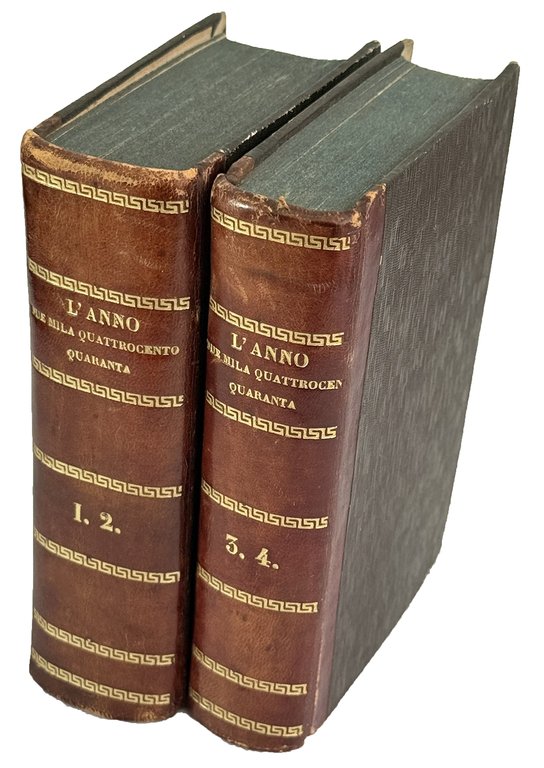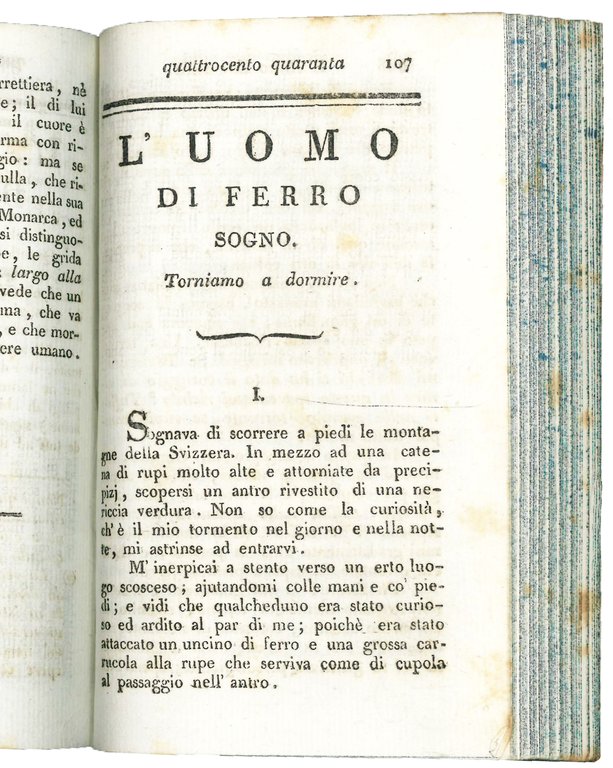


Libri antichi e moderni
MERCIER, Louis-Sébastien (1740-1814)
L'anno due mila quattrocento quaranta. Sogno di cui non vi fu l'eguale. Seguito dall'Uomo di ferro. Opera del cittad. L.S. Mercier […] Traduzione dal francese sull'ultima edizione fatta in Parigi l'anno VII. della Repubb. Francese, corretta, riveduta, ed aumentata dall'autore
Domenico Porcile & C. nella strada della Posta vecchia n.^, [1798]
1500,00 €
Govi Libreria Antiquaria
(Modena, Italia)
Le corrette spese di spedizione vengono calcolate una volta inserito l’indirizzo di spedizione durante la creazione dell’ordine. A discrezione del Venditore sono disponibili una o più modalità di consegna: Standard, Express, Economy, Ritiro in negozio.
Condizioni di spedizione della Libreria:
Per prodotti con prezzo superiore a 300€ è possibile richiedere un piano rateale a Maremagnum. È possibile effettuare il pagamento con Carta del Docente, 18App, Pubblica Amministrazione.
I tempi di evasione sono stimati in base ai tempi di spedizione della libreria e di consegna da parte del vettore. In caso di fermo doganale, si potrebbero verificare dei ritardi nella consegna. Gli eventuali oneri doganali sono a carico del destinatario.
Clicca per maggiori informazioniMetodi di Pagamento
- PayPal
- Carta di Credito
- Bonifico Bancario
-
-
Scopri come utilizzare
il tuo bonus Carta del Docente -
Scopri come utilizzare
il tuo bonus 18App
Dettagli
Descrizione
First edition in Italian of Louis-Sébastien Mercier's extremely successful utopian novel L'An 2440, rêve s'il en fut jamais (literally, ‘The Year 2440: A Dream If Ever There Was One'), which went through twenty-five editions after its first appearance in 1771. The work, which was placed on the Index on 26th August 1822, is considered a precursor to modern science fiction literature. Following a heated debate with a philosopher acquaintance in Paris about the concept of justice, the protagonist falls into a deep slumber and awakens in Paris in the year 2440. The city has been completely renovated and is inspired by the Enlightenment ideals of freedom and social progress. Starting with a harsh critique of pre-Revolutionary French society, the author goes on to describe a French capital inhabited by a classless society, where a new form of legality and the best possible government reign supreme (cf. G. Rossi, L'An 2440 di Louis-Sébastien Mercier: un'ucronia illuministica alla vigilia della Rivoluzione francese, in: “Immaginare il futuro del diritto. Narrazioni utopiche, distopiche e ucroniche”, G. Rossi, D. Velo Dalbrenta & C. Pedrazza Gorlero, eds., Naples, 2021, pp. 61-86).
Of particular interest is the passage in which Mercier describes the protagonist's astonishment at the royal library. In his day, it housed thousands of volumes, but by 2440, it had dwindled to just a few volumes in four cabinets in a vast, empty gallery. Unlike the society in which the protagonist lived, the new society had made a draconian choice of the few titles that truly deserved to be preserved, and had made a huge bonfire of all the other works deemed useless.
Only copy recorded to be in an American library.
“The translator was thought to be Filippo Castelli, however, in his Saggi di Eulogia, Genoa, 1838, he himself takes credit for having translated only ‘L'Homme de Fer'. One possibility for the translator of L'An 2440 is Elisabetta Caminer, who translated several of Mercier's dramas into Italian […] Nevertheless, Caminer had died in 1796, two years before this translation appeared. However, this translation has one of the hallmarks of her work, liberties with the original text; and her other translations of Mercier's works show her sustained interest in his writings. One can speculate that she was the one who began the translation, finishing only a part of it before her death. Castelli might well have finished the translation and gone ahead to do ‘L'Homme de Fer', which was the last part of the book. Castelli was in Genoa at this time and was active translating other French works into Italian” (E.C. Wilkie, Mercier's L'An 2440: Its Publishing History During the Author's Lifetime, in: “Harvard Library Bulletin”, XXXII, 1984, p. 393).
Italian Union Catalogue, IT\ICCU\TO0E\009541.

